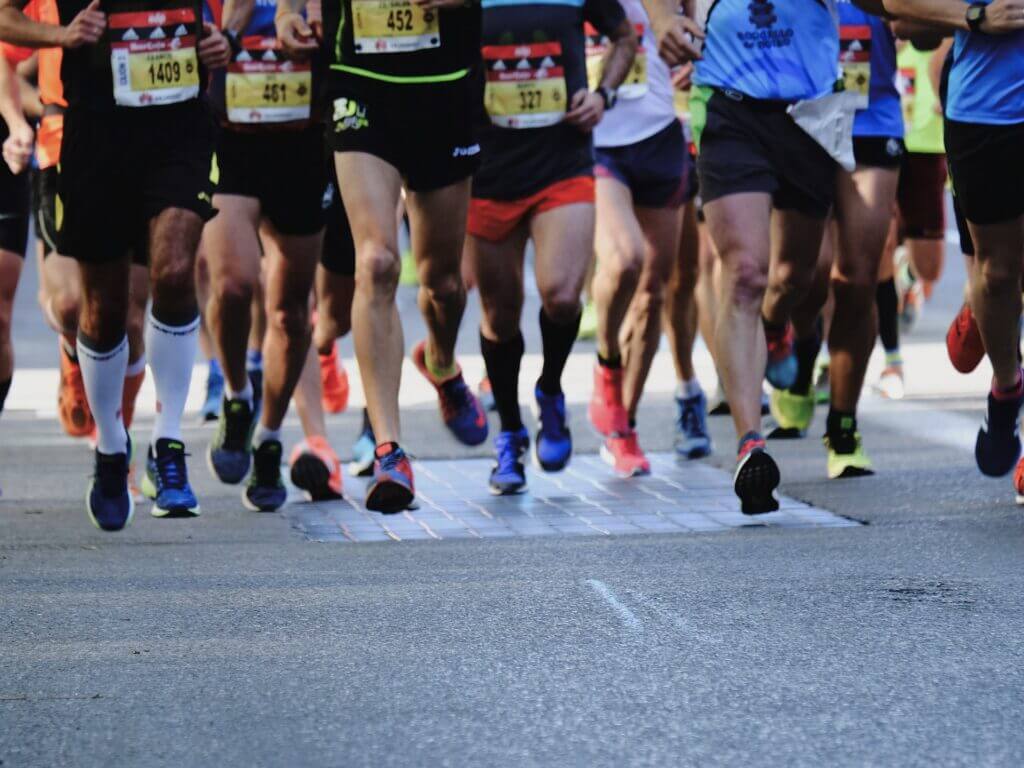Are you ready to lace up your running shoes and conquer a 5K race? Before you hit the pavement, you might be wondering, “How many steps is a 5K?” Well, fret not, my fellow aspiring runners, because I’ve got the answer for you in this blog post!
A 5K race, also known as a 5-kilometer race, covers a distance of approximately 3.1 miles. Now, when it comes to steps, the number can vary depending on factors like your stride length and running style. On average, an individual takes around 2,000 steps to walk a mile. So, for a 5K, you can estimate that you’ll be taking roughly 6,200 steps.
But hold on, don’t get overwhelmed by the numbers just yet! In this post, I’ll dive deeper into what a 5K entails, share some tips to help you prepare, and discuss the benefits of participating in such a race. So, let’s put one foot in front of the other and explore the wonderful world of 5K races together!
Table of Contents
How long is 5k?
A 5K race covers a distance of 5 kilometers, which is equivalent to approximately 3.1 miles. Now, let’s break it down to make it more relatable. Imagine walking around your neighborhood block. Typically, a standard city block is about 1/10th of a mile or roughly 528 feet long. Now, picture yourself walking around that block 31 times. That’s a distance of 5K!
To put it into perspective, if you were to walk at a moderate pace, it would take you around 45-60 minutes to complete a 5K. That’s like walking for the duration of your favorite TV show or enjoying a leisurely stroll in a park.
So, the next time you hear about a 5K race or challenge, remember that it’s about walking or running a distance of approximately 3.1 miles.
Read: How many miles is a 10k?
How long does it take to run 5K?

On average, it takes around 25 to 35 minutes to run a 5K race. Of course, this can vary depending on factors like your fitness level, running experience, and the terrain you’re running on.
To give you a better idea, imagine running at a consistent pace of 8 minutes per kilometer. In that case, it would take you approximately 40 minutes to complete a 5K. If you’re a more experienced runner and can maintain a faster pace, let’s say 6 minutes per kilometer, you could finish the race in about 30 minutes.
Remember, the joy of running a 5K isn’t solely about the time it takes but also the personal achievement and the satisfaction of crossing that finish line.
Read: How To Run A Faster Mile?
Factors That May Affect How Many Steps in a 5k
When it comes to measuring the number of steps in a 5K, there are a few factors that can influence the final count. Let’s explore these factors and understand how they can impact the step count in a 5K race.
1. Stride Length
One of the primary factors that affect the number of steps in a 5K is your stride length. Stride length refers to the distance covered with each step you take. It varies from person to person, depending on factors such as height, leg length, and running or walking style.
🚶♂️ Practical Example: Imagine two individuals, John and Sarah, participating in a 5K walk. John has a longer stride length compared to Sarah. Due to his long stride, John might take fewer steps to complete the same distance as Sarah.
2. Running vs. Walking
Whether you’re running or walking a 5K can also impact the step count. Running typically involves larger strides and a faster pace, which can result in fewer steps to cover the distance compared to walking. On the other hand, walking involves shorter strides and a slower pace, requiring more steps to complete the same distance.
🏃♀️ Practical Example: Let’s say Mark is running a 5K, while Lisa is walking the same distance. Since running involves larger strides, Mark will likely take fewer steps to complete the 5K compared to Lisa, who will take more steps due to her smaller walking strides.
3. Personal Pace
Your personal pace, whether running or walking, can affect the number of steps taken during a 5K. A faster pace usually means longer strides and fewer steps, while a slower pace may result in shorter strides and more steps.
🏃♂️ Practical Example: Suppose Tom and Emily are both running a 5K. Tom maintains a faster pace than Emily. As a result, Tom’s longer strides allow him to cover more distance with each step, reducing the total step count required to complete the 5K.
4. Terrain and Elevation
The terrain and elevation of the race route can also impact the step count in a 5K. Running or walking uphill or on uneven surfaces requires more effort and smaller steps, resulting in a higher step count.
🌄 Practical Example: Imagine a 5K race that includes a hilly section. Participants will naturally take smaller steps to tackle the uphill portions, which will increase their step count for the overall race.
By understanding these factors, you can gain insight into why step counts can vary among individuals participating in a 5K. Remember, the number of steps taken during a 5K is influenced by your stride length, running or walking style, personal pace, and the terrain of the race route.
Now that we’ve explored the factors that can affect step count let’s move on to the next section: “How many steps is 5k?” where we’ll dive into the specific step count for a 5K race.
How many steps is 5k?
When it comes to measuring steps, a 5K race covers a distance of approximately 5 kilometers or 3.1 miles. The number of steps it takes to complete a 5K can vary depending on factors like stride length, pace, and individual differences.
On average, a person takes about 2,000 to 2,500 steps to complete a mile. So, to estimate the number of steps in a 5K, we can multiply the average number of steps per mile by the distance of a 5K.
Let’s break it down with some numbers to make it easier to visualize:
- Average Steps per Mile: As mentioned earlier, the average number of steps per mile falls between 2,000 to 2,500 steps. For the purpose of this explanation, let’s consider an average of 2,200 steps per mile.
- Number of Steps in a 5K: To calculate the number of steps in a 5K, we multiply the average steps per mile (2,200) by the distance of a 5K (3.1 miles). Number of steps = Average steps per mile * Distance of 5K Number of steps = 2,200 steps/mile * 3.1 miles Number of steps ≈ 6,820 steps
So, it takes approximately 6,820 steps to complete a 5K race.
It’s important to note that this number can vary from person to person based on factors such as stride length and walking or running pace. Some individuals may take shorter or longer steps, affecting the overall step count. This estimate provides a general guideline, but individual results may vary.
Remember: Stride length matters!
Stride length plays a significant role in determining the number of steps needed to complete a 5K. If you have a shorter stride length, you may take more steps to cover the same distance compared to someone with a longer stride length. The length of your stride can be influenced by factors like height, leg length, and personal gait.
While the average number of steps for a 5K is around 6,820 steps, it’s important to focus on finding a comfortable stride length and maintaining a consistent pace throughout your race or training.
Practical Examples
To give you a better idea of how the step count can vary, let’s consider a couple of practical examples:
Example 1: Sarah, who has a shorter stride length, completes a 5K race with an average of 8,000 steps. Her shorter steps require her to take more steps to cover the distance.
Example 2: Mike, with a longer stride length, finishes a 5K race with an average of 5,500 steps. His long stride allows him to cover more distance with fewer steps.
These examples demonstrate how individual differences, such as stride length, can impact the step count required to complete a 5K race.
Summary
In summary, a 5K race covers a distance of 5 kilometers or 3.1 miles. On average, it takes around 6,820 steps to complete a 5K. However, the exact number of steps can vary depending on factors such as stride length, pace, and individual variations. Remember that finding a comfortable stride length and maintaining a consistent pace are key to achieving your goals in a 5K race.
Now that you have a better understanding of the step count for a 5K, let’s explore how you can measure your steps and some useful tips for training and running a successful 5K race.
How to Measure Your Steps Count

To accurately measure your step count, you’ll need a reliable tool called a pedometer. This small device keeps track of your steps as you walk or run. Let’s dive into the steps (pun intended) for measuring your step count.
1. Get a Pedometer
Invest in a pedometer, which is readily available in stores or as a feature on many fitness-tracking apps. Make sure to choose one that suits your preferences and budget.
2. Attach and Calibrate
Attach the pedometer securely to your waistband, belt, or wrist, depending on the type of device you have. Follow the instructions provided to calibrate it properly for accurate step counting.
3. Find Your Stride Length
Determining your stride length is crucial for precise step counting. The stride length is the distance covered in a single step. To measure your stride length, mark a starting point and walk ten steps.
Measure the distance covered in feet or meters and divide it by ten to get your average stride length. Repeat this process a few times to ensure accuracy.
4. Set Your Pedometer
Configure your pedometer to match your stride length. This step ensures that your step count is as accurate as possible. Refer to the user manual or app settings to input your stride length correctly.
5. Test Your Pedometer
Before relying on your pedometer for tracking your steps during a 5K, perform a quick test. Take a brisk walk or jog while keeping an eye on the pedometer. Compare the displayed step count with the number of steps you counted manually. If there’s a significant discrepancy, recheck the calibration or stride length settings.
6. Stride Length Variations
Keep in mind that your stride length may vary depending on your pace. For example, during a fast run, your stride length may increase, covering more distance with each step. On the other hand, during a leisurely walk, your stride length might be shorter. Adjust your pedometer settings accordingly if you switch between walking and running.
7. Monitor and Reset
Throughout your 5K or any other walking or running activity, periodically check your pedometer to ensure it’s tracking your steps accurately. Some pedometers have a reset function that allows you to start fresh for each activity, while others automatically reset at midnight.
With your pedometer in place, you’ll have a reliable companion to track your steps as you conquer your 5K challenge.
Steps for a Woman to Walk 5k
On average, a woman walking at a moderate pace can cover a distance of 5 kilometers by taking approximately 6,500 to 7,500 steps. However, the exact number of steps may vary depending on individual factors such as height, stride length, and walking speed.
To give you a better idea, let’s consider a few examples based on different heights:
| Height (ft/in) | Steps for 5k |
|---|---|
| 5’0″ | 6,700 – 7,700 |
| 5’4″ | 6,300 – 7,300 |
| 5’8″ | 5,900 – 6,900 |
| 6’0″ | 5,500 – 6,500 |
Keep in mind that these numbers are approximate and can vary from person to person. To measure your own steps more accurately, you can use a pedometer or a fitness tracker. These devices can provide real-time step counts and help you stay on track with your fitness goals.
Steps for a Man to Walk 5k
When it comes to walking a 5k, the number of steps you’ll take can vary depending on factors like your height and stride length. On average, a man with an average stride length of 2.5 feet will take around 6,562 steps to complete a 5k.
To help you understand how different heights can affect the number of steps, here’s a table that shows the approximate number of steps for men of different heights to walk a 5k:
| Height (feet) | Number of Steps for a 5k |
|---|---|
| 5’5″ | 6,874 |
| 5’8″ | 7,187 |
| 6’0″ | 7,656 |
| 6’3″ | 8,000 |
| 6’6″ | 8,344 |
For example, if you’re around 5 feet 8 inches tall, you can expect to take approximately 7,187 steps to complete a 5k. On the other hand, if you’re taller, like around 6 feet 6 inches, you’ll likely need around 8,344 steps to finish the distance.
Now that you have an understanding of the approximate number of steps involved, you can lace up your shoes, start counting your steps, and confidently tackle that 5k distance!
Steps for running a 5k
When it comes to running a 5k, the number of steps can vary depending on factors such as your height, running speed, and stride length. Let’s break it down and provide you with some practical examples to give you a clearer picture.
Here’s a table showcasing different heights and the corresponding amount of time it takes to run a 5k, along with the estimated number of steps:
| Height | 40 min 5k | 35 min 5k | 30 min 5k | 25 min 5k | 20 min 5k |
|---|---|---|---|---|---|
| 5’0″ | 6,000 | 5,200 | 4,500 | 3,800 | 3,200 |
| 5’2″ | 6,200 | 5,400 | 4,700 | 4,000 | 3,400 |
| 5’4″ | 6,400 | 5,600 | 4,900 | 4,200 | 3,600 |
| 5’6″ | 6,600 | 5,800 | 5,000 | 4,400 | 3,800 |
| 5’8″ | 6,800 | 6,000 | 5,200 | 4,600 | 4,000 |
| 5’10” | 7,000 | 6,200 | 5,400 | 4,800 | 4,200 |
| 6’0″ | 7,200 | 6,400 | 5,600 | 5,000 | 4,400 |
| 6’2″ | 7,400 | 6,600 | 5,800 | 5,200 | 4,600 |
| 6’4″ | 7,600 | 6,800 | 6,000 | 5,400 | 4,800 |
| 6’6″ | 7,800 | 7,000 | 6,200 | 5,600 | 5,000 |
Let’s take the example of someone who is 5’5″ tall and runs a 5k in 30 minutes. They would typically take around 5,100 steps to complete the race. On the other hand, if they were able to finish the 5k in just 25 minutes, they would cover approximately 4,300 steps.
Remember, the most important thing is to find a comfortable pace that suits you and allows you to enjoy the race while challenging yourself. Don’t get too caught up in the number of steps—focus on enjoying the experience and achieving your personal goals.
Now that you have an idea of the step count involved, let’s move on to exploring other interesting aspects of a 5k race.
Read: 5K Warm-Up Exercises for Peak Performance
How Many Steps in a Marathon

A marathon is a grueling race that spans a distance of 26.2 miles or 42.2 kilometers. To complete a marathon, you’ll need to take an impressive number of steps. On average, a person takes about 2,000 steps to walk or run a mile. So, let’s do the math!
For a marathon, you’ll need to take approximately 52,400 steps if you’re walking, and around 44,400 steps if you’re running. That’s a whole lot of steps!
To put it into perspective, imagine walking from one end of a football field to the other. Now, multiply that by 421 times, and you’ll get an idea of the number of steps you’ll take during a marathon.
Read: Do I Need To Fuel During A Half Marathon?
5k Running Tips
When it comes to running a 5K race, a little preparation and some helpful tips can go a long way in ensuring a successful and enjoyable experience. Here are some practical tips to help you conquer your 5K goal:
1. Set a Realistic Goal
Before you lace up your running shoes, it’s essential to set a realistic goal for yourself. Determine the time you aim to complete the race in and work towards it. For example, if you want to finish the 5K in 30 minutes, break it down to a pace of 10 minutes per kilometer.
2. Train Consistently
Consistency is key when it comes to training for a 5K. Aim to run three to four times a week, gradually increasing your distance and intensity. Start with a combination of running and walking, then progress to longer continuous runs as your fitness improves.
3. Warm-Up and Cool Down
Never skip your warm-up and cool-down routines. Before starting your run, perform dynamic stretches like leg swings and arm circles to warm up your muscles. After finishing the run, cool down with static stretches to improve flexibility and prevent muscle soreness.
4. Find Your Ideal Pace
Finding the right pace is crucial for maintaining your energy throughout the race. A sustainable pace should allow you to breathe comfortably and hold a conversation. Avoid starting too fast and burning out early. If you have a target time in mind, calculate the pace per kilometer you need to maintain to achieve it.
5. Practice Interval Training
Interval training can help improve your speed and endurance. Incorporate intervals into your training by alternating between running at a faster pace for a set distance or time and then recovering at a slower pace. For example, run at a faster pace for 400 meters, then recover with a slower jog for 200 meters. Repeat this cycle several times.
6. Stay Hydrated
Proper hydration is vital before, during, and after your 5K run. Drink water regularly throughout the day leading up to the race, and consider hydrating with sports drinks if you expect to run for longer than 45 minutes. During the race, take advantage of the water stations provided to stay hydrated.
7. Listen to Your Body
Pay attention to your body during training and on race day. If you experience pain or discomfort, don’t ignore it. Take rest days when needed, and consider seeking advice from a healthcare professional or a running coach if you have persistent pain or injuries.
8. Visualize Your Success
Mental preparation plays a significant role in running a successful 5K. Visualize yourself crossing the finish line, feeling strong and accomplished. This positive visualization can help boost your confidence and motivate you during the race.
Remember, running a 5K is both a physical and mental challenge. With consistent training, proper preparation, and a positive mindset, you can achieve your 5K goals.
5k Training Plan for Beginners
If you’re new to running and want to train for a 5k race, having a structured plan can help you progress steadily and avoid injury. Here’s a 5k training plan designed specifically for beginners. Follow this plan, and you’ll be crossing that finish line with confidence in no time!
| Week | Mon | Tue | Wed | Thu | Fri | Sat | Sun |
|---|---|---|---|---|---|---|---|
| 1 | Rest or light cross-training | 15-minute brisk walk | Rest or light cross-training | 20-minute jog/walk | Rest or light cross-training | 20-minute jog/walk | Rest or light cross-training |
| 2 | Rest or light cross-training | 20-minute jog/walk | Rest or light cross-training | 25-minute jog/walk | Rest or light cross-training | 25-minute jog/walk | Rest or light cross-training |
| 3 | Rest or light cross-training | 25-minute jog/walk | Rest or light cross-training | 30-minute jog/walk | Rest or light cross-training | 30-minute jog/walk | Rest or light cross-training |
| 4 | Rest or light cross-training | 30-minute jog/walk | Rest or light cross-training | 35-minute jog/walk | Rest or light cross-training | 35-minute jog/walk | Rest or light cross-training |
| 5 | Rest or light cross-training | 30-minute jog/walk | Rest or light cross-training | 20-minute jog/walk | Rest or light cross-training | Rest or light cross-training | 5k race day! |
Remember, during the jog/walk intervals, you can adjust the duration of running and walking based on your fitness level. As you progress, try to increase the running time and decrease the walking time gradually.
By following this 5k training plan for beginners, you’ll gradually build your endurance and improve your running performance. Don’t forget to listen to your body, stay hydrated, and give yourself proper rest days to recover.
Read: Sub 20 5K Training Plan
Final Thoughts: How Many Steps Is A 5K?
As I reflect on the journey of understanding how many steps make up a 5K, I am filled with a sense of accomplishment and newfound knowledge. Walking or running a 5K is not just about the distance covered, but also about the determination, effort, and personal growth it entails.
Whether you’re a beginner or an experienced athlete, the step count code for a 5K unlocks a world of possibilities. Remember, it’s not just about the numbers on your pedometer; it’s about embracing the challenge, celebrating your progress, and enjoying the exhilarating feeling of crossing that finish line.
So put on your shoes, take those steps, and let the magic of a 5K unfold before you. See you at the starting line!
Frequently Asked Questions
How many miles are 10,000 steps equal to?
On average, 10,000 steps is approximately equal to 5 miles. However, this can vary depending on factors like stride length and pace. So, it’s a good rule of thumb, but not an exact measurement.
How many steps is a 10K walk?
A 10K walk typically requires around 6,000 to 7,000 steps. Remember, everyone’s stride length differs, so the number of steps may vary slightly. It’s helpful to use a pedometer or fitness tracker to keep track of your steps during the walk.
How far to walk 5K steps?
Walking 5,000 steps is roughly equivalent to covering a distance of approximately 2.5 miles. Keep in mind that stride length and pace can affect this estimation. Using a step-tracking device or mobile app can give you a more accurate measurement of your progress.
How Many Kilometers is a 5k?
A 5K race covers a distance of 5 kilometers, which is approximately equal to 3.1 miles. It’s a popular distance for running events and is equivalent to walking or jogging for about 30-40 minutes, depending on your pace.


